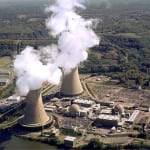Among the surprises in President Barack Obama’s second Inaugural Address on Monday was his promise to address the challenges of climate change and sustainable energy. An independent draft report released about a week earlier on climate change and its impacts in the U.S. may have helped to fuel his renewed resolve on these intertwined issues.
The full text of Obama’s January 21 comments on climate change and energy policy read: “We, the people, still believe that our obligations as Americans are not just to ourselves, but to all posterity. We will respond to the threat of climate change, knowing that the failure to do so would betray our children and future generations. Some may still deny the overwhelming judgment of science, but none can avoid the devastating impact of raging fires and crippling drought and more powerful storms.
“The path towards sustainable energy sources will be long and sometimes difficult. But America cannot resist this transition, we must lead it. We cannot cede to other nations the technology that will power new jobs and new industries, we must claim its promise. That’s how we will maintain our economic vitality and our national treasure—our forests and waterways, our crop lands and snow-capped peaks. That is how we will preserve our planet, commanded to our care by God. That’s what will lend meaning to the creed our fathers once declared.”
The Hill reported that Interior Secretary Ken Salazar, who had announced his resignation prior to the inauguration, told those at the Clean Energy Inaugural Ball, “We need to make sure that we tackle climate change in these next four years and this president is going to do it.” Other administration officials and aides made confirmatory statements regarding the priority that energy and climate change would have in Obama’s second term.
Exactly how the administration will achieve its undefined climate change goals is a matter of speculation at this point. Obama’s State of the Union speech is expected to include more details.
Actions taken during the president’s first term that could be tied to the goal of reducing greenhouse gases (GHGs) include financial incentives for renewable energy and smart grid efforts, increased fuel economy standards for vehicles, Environmental Protection Agency (EPA) regulations to reduce pollutants from fossil-fueled power generating facilities, and a directive that the federal government—the largest energy consumer in the U.S.—reduce its GHG emissions “from direct sources such as building energy use and fuel consumption by 28 percent by 2020” and reduce GHGs “from indirect sources, such as those from employee commuting, by 13 percent by 2020.”
Options for further reducing GHGs include caps for fossil-fueled power plants, regulating releases of methane from gas extraction operations, increasing building energy efficiency, and mandating further energy efficiency measures throughout the government.
Though GHG cap-and-trade legislation failed to pass Congress, GHGs are already regulated. The EPA’s Tailoring Rule, which took effect on January 2, 2011, requires all new or modified facilities to obtain an air permit before construction that governs all regulated pollutants, including GHGs. The result has been to require best emissions control technologies. (In November 2011, the EPA granted the first GHG permit in Texas, nearly a year after that state refused to implement federal GHG regulations and the federal agency seized the state’s authority to grant those permits.) California has gone further and has instituted a state-level GHG cap-and-trade program that held its first emissions allowance auction in November 2012.
And, in fact, U.S. carbon dioxide emissions have dropped, 7.7% since 2006, according to the International Energy Agency. A faltering economy, coal-to-gas switching, government regulations, and more-efficient vehicles, buildings, and appliances all have played a role in those reductions. Looking forward, the U.S. Energy Information Administration says in its Annual Energy Outlook 2013 Early Release Overview, “The projected growth rate for U.S. energy-related CO2 emissions has declined successively in each Annual Energy Outlook since AEO2005 . . ., reflecting both market and policy drivers.”
Although most who follow the climate change debate recognize that U.S. GHG reductions will have minimal effect on global climate change given the developing world’s increasing reliance on fossil fuels, the real lever of change that the president may be considering is technology innovation. Even in his first term, Obama repeatedly mentioned fostering American technology leadership and industrial capability as rationales for programs designed to accelerate the development of alternative energy options.
Along those lines, a Pew Charitable Trusts report released January 17 and titled “Innovate, Manufacture, Compete: A Clean Energy Action Plan” stated that “revenue in the clean energy sector worldwide could total $1.9 trillion from 2012 to 2018.” However, “roundtable discussions with more than 100 U.S. industry leaders reveal that the country is at a crossroads: Private investment, manufacturing, and deployment of renewable power have been constrained because of the lack of a long-term, consistent energy policy.”
Though many of those who supported Obama in last fall’s election may have been disappointed that he was virtually silent on the issue of climate change during the campaign, recent events may have persuaded him to be more open about his intentions. Following the devastation of Hurricane Sandy and the way the Republican governors of New York and New Jersey have been coordinating post-storm efforts with Washington, the administration could be hoping that some Republicans may be more inclined to consider new proposals.
Another prompt may have been a recent report on anticipated U.S. climate change impacts. A January 11 post by John P. Holdren, assistant to the president and director of the White House Office of Science and Technology Policy, and Jane Lubchenco, administrator of the National Oceanic and Atmospheric Administration—titled “Expanding the Climate Change Conversation”—got little media coverage. However, the report it cites—along with continuing post–Hurricane Sandy challenges—may have played into the drafting of Obama’s Martin Luther King Jr. Day speech. The draft National Climate Assessment (NCA) is a 400-page “synthesis of scientists’ current understanding of climate change and its impacts in the United States.”
Holdren and Lubchenco note that “The Global Change Research Act of 1990 calls for an NCA to be produced at least every four years—the last came out in 2009. The draft NCA is a scientific document—not a policy document—and does not make recommendations regarding actions that might be taken in response to climate change.”
Though the NCA does not recommend policy, it “is expected to be used widely by public and private stakeholders who need information about climate change in order to thrive—from farmers deciding which crops to grow, to city planners deciding the diameter of new storm sewers they are replacing, to electric utilities and regulators pondering how to protect the power grid.”
The final NCA is scheduled for release in about a year, after taking comments from the public and expert reviewers and promises to be “the most thorough, rigorous, and transparent assessment ever of climate change and its U.S. impacts.”
Sources: POWERnews, The Hill, The White House, IEA, EIA, Pew Charitable Trusts
—Gail Reitenbach, PhD, Managing Editor (@GailReit, @POWERmagazine)









